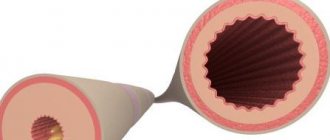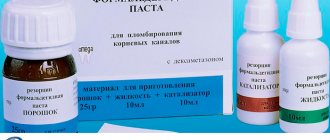Release form and composition
- solution for intravenous (IV) and intramuscular (IM) administration: transparent, with a faint odor of benzyl alcohol, colorless to light yellow (3 ml in ampoules, 5 ampoules in a plastic tray, 1 tray in a cardboard box );
- solution for intramuscular administration (2 ml in ampoules, 1, 3 or 5 ampoules in a plastic tray, 1 or 2 trays in a cardboard box);
- extended-release, film-coated tablets: round, with beveled edges, pink in color, with a uniform and smooth surface; a white core is visible on the fracture (10 pieces in blisters, 2 blisters in a cardboard box);
- rectal suppositories: cone-shaped, yellowish-white in color, with a faint odor of fat; on the longitudinal section there may be a funnel-shaped depression or an air rod (5 pieces in strips, 2 strips in a cardboard box);
- gel for external use (60 g in aluminum tubes, 1 tube in a cardboard box).
The active substance of Diclonate P is diclofenac sodium, its content:
- 1 ml of solution for IV and IM administration – 25 mg;
- 1 ml of solution for intramuscular administration – 37.5 mg;
- 1 tablet – 100 mg;
- 1 suppository – 50 mg;
- 1 g of gel – 10 mg.
Auxiliary components of Diclonate P depending on the form of release:
- solution for injection: sodium hydroxide, mannitol, sodium metabisulfite, water for injection, propylene glycol, benzyl alcohol;
- tablets: colloidal silicon dioxide, polyvidone, sucrose, magnesium stearate, cetyl alcohol; shell: polysorbate, polyethylene glycol, hydroxypropyl methylcellulose, titanium dioxide, talc, sucrose, red iron oxide (E172);
- suppositories: solid fat;
- gel: ammonium solution 25%, propylene glycol, liquid paraffin, cethiol, isopropyl alcohol, cetomacrogol, carbomer 934, purified water, lavender flavor.
Release form and packaging
The drug has different dosage forms.
Solution for injections
The product has a high degree of transparency, has no color or is light yellow. The aroma of benzyl alcohol is light and unobtrusive. The medication is available in ampoules of 3 ml. Ampoules are located in pallets of 5 pieces. The packaging is made of cardboard. Each contains one tray and one instructions for using the product.
Solution for injection into muscle
The drug has a high degree of transparency, has no color or is light yellow. The product is available in ampoules of 2 ml. Ampoules are located in pallets of 1, 3 or 5 pieces. The packaging is made of cardboard. Each contains one or two trays and one instruction manual for using the product.
Pills
They represent a means of delayed effect. The tablets are white inside but coated with a pink coating. The shape is round, the surface is smooth. The product is placed in a blister containing 10 tablets. The packaging is made of cardboard. Each contains 2 blisters and one instruction for using the tablets.
Candles (suppositories)
The product has a bullet shape, a faint aroma of fat and a light yellow tint. Consistency – gel-like, homogeneous. At the bottom of the candle there is a funnel-shaped recess. The product is available in strips. There are 5 candles in one strip. The packaging is made of cardboard. Each contains 2 strips and one instructions for using candles.
Gel
The drug is intended for external use. The consistency is creamy. The product has a medium degree of transparency (translucent) and white shades. It has a faint aroma of isopropyl alcohol and lavender flowers. The product is available in aluminum tubes. Volume – 60 ml. Packaging: cardboard. Each contains 1 tube and one instructions for use.
Pharmacological properties
Diclofenac sodium is a phenylacetic acid derivative that has anti-inflammatory, antipyretic and analgesic effects.
The substance indiscriminately inhibits cyclooxygenase 1 and cyclooxygenase 2, as a result of which it disrupts the metabolism of arachidonic acid and suppresses the biosynthesis of prostaglandins - hormone-like substances that are mediators of inflammation, pain and fever.
Thanks to these properties, diclofenac reduces swelling in the joints, relieves pain (both at rest and during movement), and reduces morning stiffness in rheumatic diseases.
Pharmacokinetics
Diclofenac is rapidly absorbed regardless of the route of administration - intravenous, oral or rectal.
After intramuscular administration of a single dose of diclofenac of 75 mg, the maximum concentration (Cmax) in plasma (2.5 μg/ml, or 8 μmol/l) is observed after 20 minutes and is linearly dependent on the volume of the administered dose.
After intravenous drip administration of a similar dose, the Cmax of diclofenac is 1.9 µg/ml (or 5.9 µmol/l), observed for more than 2 hours and inversely related to the time of infusion of Diclonate P.
When taking the prolonged form of Diclonate P orally, Cmax (0.5 μg/ml) is achieved within 5 hours, when administered rectally - after 30 minutes. The plasma concentration is linearly dependent on the dose of diclofenac received.
Up to 99% of the drug binds to plasma proteins, most of it to albumin.
If the recommended dosing intervals are observed, accumulation of the drug substance is not observed. It is well distributed throughout the tissues and fluids of the body, including penetrating into the synovial fluid.
The drug is metabolized in the liver with the participation of the P450 CYP 2C9 enzyme system, with 50% being metabolized during the “first pass” through the liver. AUC after parenteral administration is 2 times greater than after oral administration of the drug. The pharmacological activity of the metabolites is lower than that of diclofenac.
The drug is excreted mainly through the kidneys: 60% - in the form of metabolites, less than 1% - in its pure form. The rest is excreted in bile in the form of metabolites. The half-life from blood plasma is 1–2 hours. Systemic clearance is 260 ml/minute.
Depending on the age of the patient and with repeated administration of Diclonate P, the pharmacokinetics do not change.
In patients with severe renal impairment (creatinine clearance <10 ml/minute), the excretion of metabolites in bile increases, but their concentration in the blood does not increase.
In patients with compensated liver cirrhosis or chronic hepatitis, the pharmacokinetic parameters of diclofenac are similar to those in patients without liver disease.
When diclofenac (Diclonat P gel) is used externally, absorption is no more than 6%. In this case, about 99.7% of the drug is bound to proteins. It is also excreted mainly by the kidneys. When applied to the area of the affected joint, the concentration of the substance in the synovial fluid is higher than in plasma.
Composition and release forms
The therapeutic effect of Diclonate P is provided by its active component diclofenac sodium. The drug is produced in several dosage forms. The following types are sold in the pharmacy:
- Round tablets with beveled edges, coated with a pink food coating. Packaged in 10 pcs. in blister packs. Each cardboard pack contains 2 packages.
- Solution for intravenous or intramuscular administration. It is a clear, colorless or pale yellow liquid. Glass ampoules, each containing 3 ml of medicine, are placed in 5 pieces. in plastic pallets. The box contains 1 pallet.
- Solution for intramuscular injection. It is produced in the form of a transparent liquid without color or colored yellowish. Sold in ampoules of 2 ml. A package made of thick paper may contain 1, 3, 5 or 10 ampoules of the drug.
- Suppositories for rectal use are torpedo-shaped with a light yellow surface. Placed in blisters of 5 pcs. There are 2 blisters in a cardboard box.
- Gel for external use in the form of a homogeneous translucent white mass with a pleasant lavender aroma. Packaged 60 g in aluminum tubes, each of which is placed in a separate cardboard package.
Indications for use
For intramuscular injections, tablets and suppositories:
- pain syndrome (rheumatic soft tissue damage, lumbago, myalgia, sciatica, bursitis, tendovaginitis, neuralgia, toothache and headache, migraine and pain of other origins of moderate severity);
- postoperative pain;
- post-traumatic pain syndrome accompanied by inflammation;
- degenerative diseases of the musculoskeletal system (deforming osteoarthritis, osteochondrosis);
- inflammatory processes in the pelvis, primary algodismenorrhea, adnexitis, proctitis, renal or biliary colic;
- inflammatory diseases of the musculoskeletal system (acute gouty arthritis, ankylosing spondylitis, juvenile chronic, psoriatic and rheumatoid arthritis);
- febrile syndrome;
- infectious and inflammatory ENT diseases with severe pain, such as otitis media, pharyngitis, tonsillitis (as part of complex therapy).
For intravenous drip infusions: treatment and prevention of postoperative pain syndrome.
For external use in gel form:
- inflammatory diseases of the musculoskeletal system (gouty arthritis, ankylosing spondylitis, juvenile chronic, psoriatic and rheumatoid arthritis, rheumatic lesions of soft tissues);
- inflammation of muscles, ligaments, joints and tendons of a traumatic nature (due to bruises, stress, sprains);
- pain syndrome (rheumatic soft tissue damage, lumbago, myalgia, sciatica, bursitis, tendovaginitis, neuralgia, degenerative diseases of the musculoskeletal system: osteochondrosis, deforming osteoarthritis).
Indications for use
Diclonate P in the form of tablets, injection solution and rectal suppositories is used in complex treatment:
- pathologies of the musculoskeletal system of an inflammatory or degenerative nature (ankylosing spondylitis, osteochondrosis, various forms of arthritis, etc.);
- moderate pain syndrome of various origins (headaches, dental and muscle pain, neuralgia, sciatica, etc.);
- post-traumatic syndrome accompanied by an inflammatory process;
- renal and biliary colic;
- inflammation of the rectal mucosa (proctitis);
- gynecological diseases of inflammatory origin (oophoritis, salpingitis);
- painful menstruation.
In addition, the listed forms of release of Diclonate P are used to reduce temperature during a febrile state and to relieve pain after surgical interventions.
External gel is used for local treatment of rheumatic and non-rheumatic muscle pain, arthritis, arthrosis, injuries and inflammation of joints, ligaments and tendons.
Contraindications
Absolute contraindications
In the form of an injection solution, tablets and rectal suppositories, Diclonate P is contraindicated in the following cases:
- various hemostasis disorders (including hemophilia);
- inhibition of bone marrow hematopoiesis;
- exacerbation of erosive and ulcerative lesions of the gastrointestinal tract (GIT), bleeding from the GIT;
- conditions associated with a high risk of bleeding (including history);
- aspirin asthma;
- pregnancy and lactation;
- age up to 15 years;
- hypersensitivity to the components of the drug or other NSAIDs, including acetylsalicylic acid.
Additionally for rectal suppositories: trauma or inflammation of the rectum (including anus), proctitis, hemorrhoids, rectal bleeding.
According to the instructions, Diclonate P in the form of a gel for external use is contraindicated in the following cases:
- violation of the integrity of the skin at the site of intended application;
- children under 6 years of age;
- hypersensitivity to the components of the drug or other NSAIDs.
Relative contraindications
For injection solution:
- erosive and ulcerative diseases of the gastrointestinal tract without exacerbation;
- edema syndrome;
- postoperative period;
- bronchial asthma;
- inducible acute hepatic porphyria;
- diverticulitis;
- liver or kidney failure;
- anemia;
- arterial hypertension;
- congestive heart failure;
- diabetes;
- alcoholism;
- elderly age.
For tablets and suppositories:
- hepatic porphyria;
- history of severe renal and liver dysfunction;
- erosive and ulcerative diseases of the gastrointestinal tract beyond the acute stage;
- congestive heart failure.
For gel:
- bleeding disorders (including hemophilia, tendency to bleed, prolongation of bleeding time);
- severe dysfunction of the liver and kidneys;
- hepatic porphyria during exacerbation;
- chronic heart failure;
- erosive and ulcerative lesions of the gastrointestinal tract in the acute phase;
- urticaria, acute rhinitis or bronchial asthma caused by taking NSAIDs, including acetylsalicylic acid;
- III trimester of pregnancy;
- lactation;
- elderly age.
Instructions for use of Diclonate P: method and dosage
Injection
Diclonate P is administered intramuscularly or intravenously as a drip infusion. The duration of treatment should not exceed two days. If it is necessary to continue therapy, the patient is transferred to the drug in the form of tablets or suppositories.
Diplonate P injections (intramuscular) are administered for acute pain at a dose of 75 mg 1 time per day. In case of severe pain syndrome (for example, with renal or biliary colic), it is possible to increase the daily dose to 150 mg - 75 mg 2 times a day.
The drug is administered intravenously as a drip infusion. Immediately before administration, 1 ampoule is diluted with 100–500 ml of 0.9% sodium chloride solution or 5% dextrose solution (after adding 0.5 ml of 8.4% sodium bicarbonate solution to the infusion solutions).
For the treatment of moderate to severe postoperative pain, Diclonate P is administered at a dose of 75 mg over 30–120 minutes. If the effect is not enough, the drug is re-administered after a few hours. No more than 150 mg can be administered within 24 hours.
To prevent postoperative pain, a loading dose of 25–50 mg is prescribed, administered over 15–60 minutes, then Diclonate P is continued to be administered at a rate of 5 mg/hour until a maximum dose of 150 mg is administered.
Long-acting tablets
In tablet form, Diclonate P should be taken orally during or after meals: swallow whole and drink plenty of water.
Usually prescribed 1 tablet 1 time per day. If the effect is not enough, another drug containing diclofenac as an active substance is additionally prescribed at a dose of 50 mg. The maximum daily dose is 150 mg.
Rectal suppositories
Suppositories Diclonat P are administered rectally at 50 mg 2 times a day or 100 mg 1 time a day.
For the first attacks of migraine, it is recommended to use 100 mg; if necessary, the drug can be repeated in a similar dose.
Gel for external use
In gel form, Diclonate P is applied to the skin in the affected areas and lightly rubbed in 3-4 times a day.
The amount of the drug depends on the size of the painful area. A single dose is 2–4 grams (a strip of gel 4 to 8 cm long).
The duration of therapy without consulting a doctor should not exceed 10 days.
Instructions for use
Diclonate P solution is used for injection by injecting the drug into the muscle using a syringe. It is also used by drip into a vein.
Instructions for using Diclonate P injections: for acute pain syndrome - 1 ampoule per day, if pain appears, you can give a second injection. The treatment period is no more than two days.
Intravenous administration of the drug is prescribed through an internal clock drip. If the pain does not subside, the procedure is repeated in the evening. This method of therapy is carried out in a clinical setting. Cannot be used at home. The period of therapy should not exceed two days, otherwise an overdose will occur, which will negatively affect the condition of the body.
Diclonate P suppositories are administered rectally, 1 suppository twice a day. For acute pain syndrome, it is recommended to use 2 suppositories once a day.
Gel Diclonate P is used externally. The product is applied over the problem area and rubbed in with massaging movements. The number of procedures is 2-3 times a day.
Side effects
Solution for injection, tablets, rectal suppositories
Classification of side effects: often - > 1/100, infrequently - from < 1/100 to > 1/1000, rarely - < 1/1000.
Possible adverse reactions:
- from the digestive system: dry mouth, constipation, erosive and ulcerative lesions of the gastrointestinal tract (including damage to the esophagus and stomach, peptic ulcer, multiple lesions of the gastrointestinal tract), nonspecific colitis with bleeding, gastrointestinal bleeding (hematemesis, melena), pancreatitis, perforation of the intestinal wall (burning in the epigastric region, intense cutting pain, melena, bloody stools), NSAID-associated gastropathy (heartburn, belching, abdominal pain, diarrhea, flatulence, discomfort in the epigastric region, feeling of fullness in the stomach, nausea, vomiting, gastralgia) , toxic hepatitis; uncommon – soreness and dryness of the oral mucosa, aphthous stomatitis (white plaque on the oral mucosa, erosions, ulcers), loss of appetite, anorexia, colitis or its exacerbation, spasms, vomiting;
- from the nervous system: often – headache, dizziness; uncommon – drowsiness, insomnia, irritability, increased fatigue, fear, nervousness, memory loss, psychotic reactions, aseptic meningitis, convulsions, depression, peripheral polyneuropathy (pain or weakness in the muscles of the arms and legs, tremor, hypoesthesia);
- from the genitourinary system: often – fluid retention; uncommon – oliguria or anuria, cystitis, decreased or worsened renal function, hematuria, proteinuria, pollakiuria, peripheral edema, interstitial nephritis, nephrotic syndrome, dysmenorrhea, recurring vaginal pain of unknown origin;
- from the cardiovascular system: often - increased blood pressure; uncommon – cardialgia, arrhythmias, collapse; rarely – chest pain, worsening congestive heart failure;
- from the respiratory system: infrequently – shortness of breath;
- from the hematopoietic organs: infrequently - anemia associated with internal bleeding, aplastic anemia, hemolytic anemia, neutropenia, leukopenia, agranulocytosis, thrombocytopenia with or without purpura, ecchymosis;
- endocrine disorders: rarely - weight loss;
- from the skin: often – skin hyperemia, skin rash (mainly erythematous and urticarial), itching; uncommon – photodermatitis (skin rash, severe sunburn, pigmentation disorder), erythema multiforme exudative (including Stevens-Johnson syndrome, Lyell’s syndrome); rarely at the site of intramuscular injection - burning, aseptic necrosis, possible infiltration, necrosis of adipose tissue;
- from the senses: often - scotoma, diplopia, decreased visual acuity, toxic amblyopia, tinnitus, hearing loss and other hearing impairments;
- allergic reactions: rarely - anaphylaxis and anaphylactoid reactions (skin itching, urticaria, focal hyperemia, pressing pain in the chest, shortness of breath, wheezing, Quincke's edema in the eyelids or paraorbital tissues, lips, tongue and glottis, anaphylactic shock), bronchospastic allergic reactions .
Gel for external use
- from the skin: rarely - redness, burning, itching, rash, contact dermatitis (hyperemia, itching, swelling of the treated area of the skin, peeling, papular-vesicular rashes), photosensitivity, eczema;
- allergic reactions: urticaria, erythematous skin rash, systemic anaphylactic reactions (including shock), angioedema.
With long-term treatment or application of Diclonat P gel to large areas of the body, there is a possibility of developing systemic side effects characteristic of diclofenac.
Diclonate P
From the digestive organs. More often than 1% - abdominal pain or spasm, bloating, diarrhea, dyspepsia, nausea, constipation, flatulence, increased activity of liver transaminases, peptic ulcer, incl. with complications (perforation, bleeding), gastrointestinal bleeding without ulcer.
Less often than 1% - vomiting, jaundice, melena, blood in the stool, damage to the esophagus, aphthous stomatitis, dry mucous membranes (including the oral cavity), hepatitis, hepatonecrosis, cirrhosis, hepatorenal syndrome, changes in appetite, pancreatitis (including .ch. with concomitant hepatitis), colitis.
From the nervous system. More often than 1% - headache, dizziness.
Less often than 1% - sleep disturbance, drowsiness, depression, diplopia, anxiety, irritability, aseptic meningitis, convulsions, weakness.
From the senses. More often than 1% - tinnitus.
Less often than 1% - blurred visual perception, taste disturbance, hearing loss (including irreversible), scotoma.
From the side of the skin. More often than 1% - skin rash, itchy skin.
Less commonly 1% - alopecia, urticaria, eczema, toxic dermatitis, exudative erythema multiforme (including Stevens-Johnson syndrome), toxic epidermal necrolysis (Lyell's syndrome), photosensitivity.
From the genitourinary system. More often than 1% is fluid retention.
Less often than 1% - nephrotic syndrome, proteinuria, oliguria, interstitial nephritis, papillary necrosis, acute renal failure, azotemia.
From the hematopoietic organs. Less often than 1% - anemia (including hemolytic and aplastic), leukopenia, thrombocytopenia, eosinophilia, agranulocytosis, thrombocytopenic purpura.
From the respiratory system. Less often than 1% - cough, bronchospasm, laryngeal edema.
From the SSS side. Less often than 1% - increased blood pressure, congestive heart failure.
Allergic reactions. Less often than 1% - swelling of the lips and tongue, anaphylactoid reactions, anaphylactic shock (usually develops rapidly). Overdose. Symptoms: dizziness, headache, hyperventilation, clouding of consciousness, in children - myoclonic convulsions, nausea, vomiting, abdominal pain, bleeding, impaired liver and kidney function.
Treatment: gastric lavage, activated charcoal, symptomatic therapy aimed at eliminating increased blood pressure, renal dysfunction, convulsions, gastrointestinal irritation, respiratory depression. Forced diuresis and hemodialysis are ineffective.
Overdose
In case of an overdose of Diclonate P in the form of a solution, tablets or suppositories, the following symptoms may occur: gastrointestinal phenomena, decreased blood pressure, disorders of the central nervous system (from drowsiness and lethargy to convulsions and even coma), nephrotoxicity up to the development of acute renal failure . Treatment: symptomatic and supportive therapy aimed at eliminating existing symptoms. Hemodialysis and forced diuresis are ineffective.
When using Diclonat P gel, an overdose is unlikely due to low systemic absorption during external application of the drug. Accidental ingestion may cause systemic side effects. In this case, it is recommended to lavage the stomach, induce vomiting, take activated charcoal, and, if necessary, carry out forced diuresis and symptomatic therapy.
special instructions
During treatment with dosage forms of Diclonate P for systemic use, it is necessary to monitor the peripheral blood picture, liver and kidney function, and conduct a stool examination for the presence of blood. You should not drink alcoholic beverages.
Gel Diclonat P is intended for external use only. It should be applied only to intact areas of the skin. Do not apply an occlusive dressing. Avoid contact with open wounds, mucous membranes and eyes.
Impact on the ability to drive vehicles and complex mechanisms
During treatment with injection solution, tablets or suppositories Diclonat P, it is recommended to refrain from activities that require speed of reactions and increased attention, including driving a car and working with complex mechanisms.
Drug interactions
The effect of diclofenac on other concomitantly used drugs:
- reduces the effect of antihypertensive and hypnotics;
- increases the plasma concentration of lithium, digoxin, cyclosporine, methotrexate;
- reduces the effect of hypoglycemic drugs;
- reduces the effect of diuretics;
- increases the toxicity of methotrexate;
- increases the nephrotoxicity of cyclosporine.
Effect of other drugs on diclofenac:
- acetylsalicylic acid reduces its concentration in the blood;
- drugs that block tubular secretion increase its concentration in the blood plasma and, as a consequence, the effect and toxicity;
- paracetamol increases the risk of developing its nephrotoxic effects;
- agents that cause photosensitization increase its sensitizing effect to ultraviolet radiation;
- gold preparations and cyclosporine increase its effect on prostaglandin synthesis in the kidneys and, as a consequence, nephrotoxicity.
Other interaction reactions when used simultaneously with Diclonate P:
- potassium-sparing diuretics: increases the risk of hyperkalemia;
- anticoagulants, thrombolytic drugs (urokinase, alteplase, streptokinase): the likelihood of bleeding increases (usually from the gastrointestinal tract);
- glucocorticosteroids, other NSAIDs: the risk of side effects increases;
- valproic acid, cefoperazone, cefamandole, plicamycin, cefotetan: the incidence of hypoprothrombinemia increases;
- ethanol, St. John's wort preparations, corticotropin, colchicine: the risk of bleeding in the gastrointestinal tract increases.
There is no information on the drug interactions of diclofenac when used externally in gel form.
Reviews of Diclonate P
According to reviews, Diclonate P is considered an effective and affordable drug that can quickly cope with pain and inflammation.
Reviews about the gel are mostly positive. The drug provides good pain relief for bruises, sprains, back and joint pain. The great advantage of this dosage form is its good tolerability.
As for Diclonate P tablets and injections, approximately 20% of patients develop various complications, including quite serious ones, which is their main drawback, despite the high analgesic and anti-inflammatory effect.
Diclonate P suppositories can also cause side effects. However, with strict adherence to the doctor’s recommendations, they can quickly achieve the desired result.




